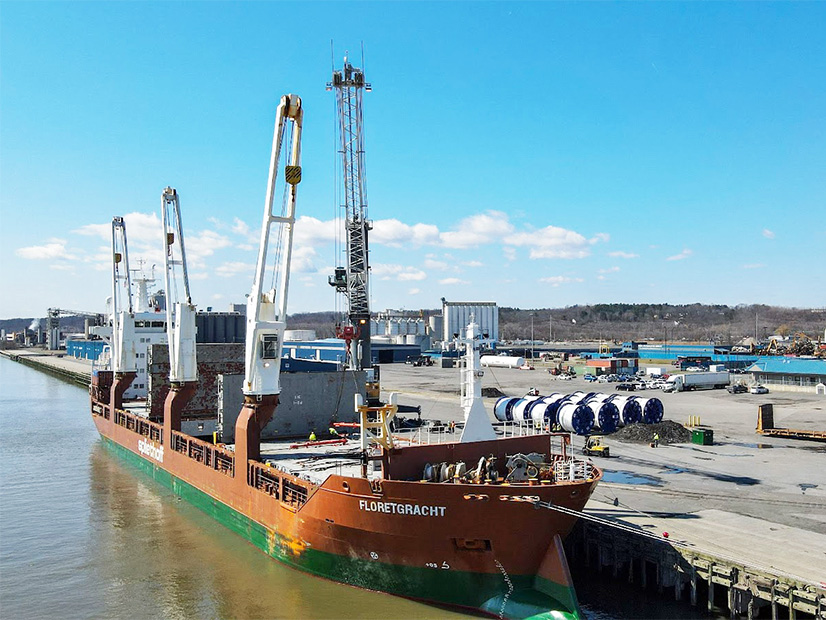
Thirteen years after the Champlain Hudson Power Express was first proposed, the first shipment of HVDC cable needed to build it arrived in New York on Thursday.
The 35 drums each hold 2,000 to 3,000 feet of cable. More than 500 drums will be needed to build the roughly 140-mile underground sections of the 339-mile, 1,250-MW line from Quebec to New York City.
The 190-mile underwater portion of CHPE will require an even greater amount of cable, which will be essentially the same except for an extra layer of exterior protective material.
The logistics of the shipment were fairly straightforward: a 3,829-mile journey aboard a freighter from Karlskrona, Sweden, to the Port of Albany, then another 53 miles by truck to CHPE’s staging area in Fort Edward.
The regulatory process, not so much.
Since Transmission Developers Inc. submitted 10 paper and 10 electronic copies of its request for a certificate of environmental compatibility and public need to the New York Public Service Commission on March 29, 2010, the expected price tag has more than doubled; the designed electrical capacity has shrunk by more than a third; and 4,573 additional documents have been submitted into the public record as part of PSC case No. 10-T-0139.
The project is an important piece of New York state’s clean energy strategy, importing emissions-free hydroelectric power to the largest U.S. city, which has very limited options for siting renewable energy generation within its own borders and relies instead on fossil fuel plants.
When completed, it will be the longest fully underground power line in the U.S., with an expected carbon impact equal to taking more than half a million internal-combustion-engine cars off the road per year.
NYISO considers CHPE important to New York state’s future grid reliability, so much so that if it is delayed, New York City’s transmission security margins could be deficient.
Some developments in the last 13 years:
- The initial proposal was for two 1,000-MW HVDC circuits; it was subsequently revised to a single 1,000-MW line; in its final form, CHPE is a single 1,250-MW line.
- CHPE had to deal not only with state and federal regulators but owners of the railroad grades where much of the overland portion of the line will be buried. It also had to negotiate payments to 132 taxing entities along the route (total cost: $1.4 billion over the first 25 years) and execute project labor agreements with more than a dozen unions.
- The initial 2010 request to the PSC indicated the developers would seek a $2.3 billion loan guarantee; the price tag was publicly estimated at $2 billion in 2013; the PSC raised the debt ceiling to $4.5 billion in early 2022 and then $6 billion later in 2022.
- The PSC approved construction and operation of CHPE in April 2013, but the docket shows very few filings over the next six and a half years; the PSC did not approve the CHPE contract until April 2022.
- CHPE in August 2022 said it was pushing the estimated in-service date of the line back from late 2025 to the spring of 2026, because of regulatory delays and supply chain constraints; on Thursday it said only that the line would start delivering power in 2026.
- A ceremonial groundbreaking was held in November 2022, but that was only for two staging areas; the PSC did not issue the notice to proceed with actual construction of the line until Feb. 27, 2023.
- And as all this was happening, the 2,100 MW of emissions-free energy produced by the Indian Point nuclear plant — 20 miles north of New York City and right along the path of CHPE — went offline permanently; New York state codified a clean-energy transition; and New York City moved to ban fossil fuels in new construction, simultaneously reducing the supply and increasing the demand for clean energy well beyond whatever CHPE will provide.
As of Thursday, 4,574 documents have been filed with the PSC in the CHPE case, for everything from the overland rock removal permit to requests for nondisclosure to electrical drawings to a special hauling permit (cost: $40) for an oversized office trailer.
One of the newest documents, filed Wednesday, is an update on the regulatory situation on the other side of the border. It indicated three main authorizations are still required for construction of the Hertel-New York Interconnection Project, the roughly 35-mile underground line in Quebec that will connect to CHPE.
They are: authorization from the government of Quebec under the Environmental Quality Act; a permit from the Canada Energy Regulator; and authorization from the Regie de l’energie du Quebec (the Quebec Energy Board). All are expected by the end of this summer, the filing indicates.
Anticipating long lead times, Hydro-Quebec already has signed a contract with NKT to manufacture underground cables and is negotiating with NKT to install them. It expects to execute a contract with Hitachi to manufacture converter equipment shortly.
Hydro-Quebec is still negotiating property easements to site the line but has been authorized by the government of Quebec to take what it needs by eminent domain if necessary.


